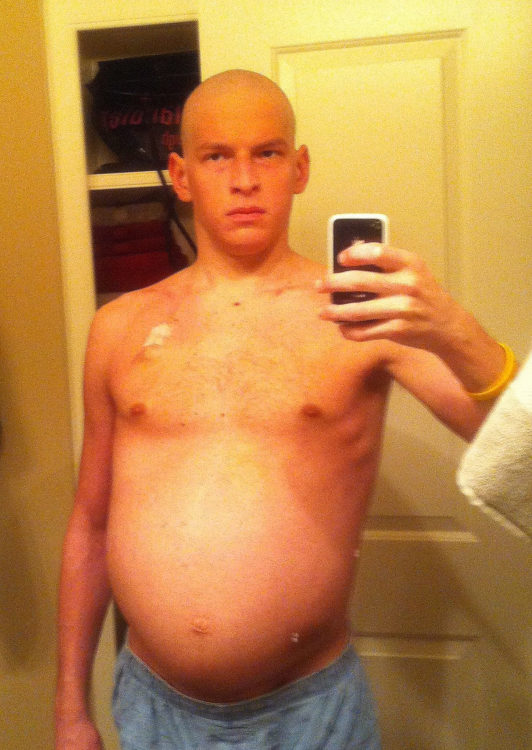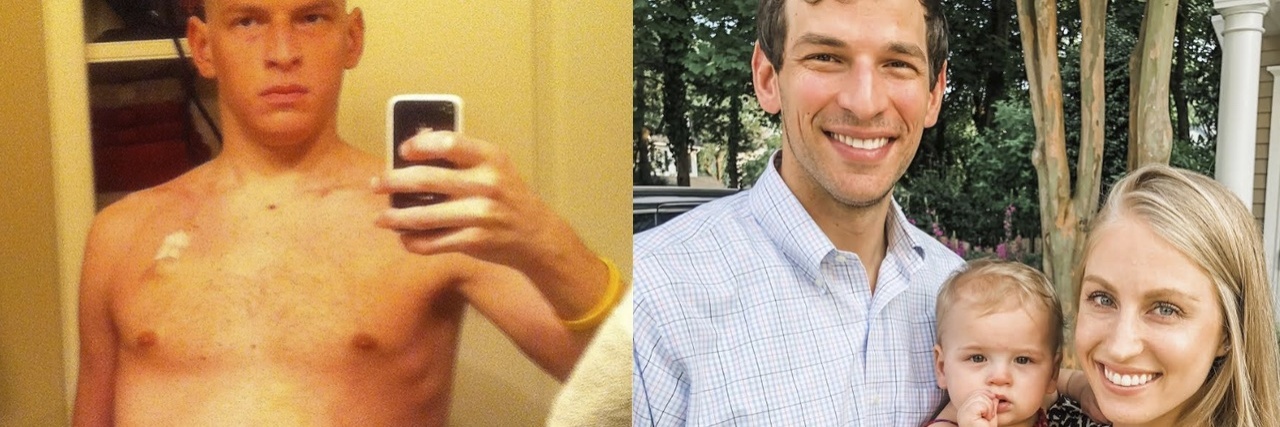I became ill with iMCD during my third year of medical school in 2010 and had my last rites read when my doctors didn’t think I would survive my immune system’s attack on my vital organs. I’ve considered that to be the start of my “overtime.” I survived thanks to chemotherapy but went on to relapse and nearly die four more times.
Before I share more details about my personal journey, let me give a bit of background on the disease. Lymph nodes play an important role in your body’s immune system. They house the cells that monitor for threats (viruses, bacteria, cancer, etc) and coordinate your body’s immune response. But in people with Castleman disease, immune cells become hyperactive and proliferate even when there isn’t a known threat. The lymph nodes enlarge and the hyperactive immune cells produce inflammatory molecules that can make people with Castleman disease feel as though they’re constantly fighting off the flu. In severe cases, the excess production of these inflammatory molecules can cause dysfunction of the liver, kidneys, and bone marrow.
Researchers have identified two major subtypes of Castleman disease: Unicentric Castleman disease (UCD) and Multicentric Castleman disease (MCD). UCD is the most common, and involves enlargement of one lymph node or one region of nearby lymph nodes with limited symptoms. MCD involves enlargement of multiple regions of lymph nodes and potentially life-threatening organ dysfunction. There are at least three further subtypes of MCD:
- HHV-8-associated MCD, which is caused by uncontrolled infection with the HHV-8 virus
- POEMS-associated MCD, which is caused by the proliferation of a cancerous cell
- HHV-8-negative/idiopathic MCD (iMCD), which has an unknown cause
Castleman disease can seriously impact your quality of life, and MCD is life-threatening. When I relapsed on the only drug in development for iMCD, I promised my family and fiancée that I’d dedicate my life to searching for treatments for myself and others.
I created the Castleman Disease Collaborative Network and began conducting laboratory research. I knew that I wouldn’t make it to my fiancée and I’s wedding day if I didn’t find a drug to save me, so I performed studies and eventually identified a drug developed 25 years ago for another condition that I thought could work and began taking it.
Fortunately, treatment discovery and advocacy efforts have come a long way in recent years. The prognosis for people living with Castleman disease is better than ever, though more work is critically needed. Today, I’m in my longest remission ever (71.48 months)! I made it to my wedding day, and my wife and I had a daughter 16 months ago.
I recently wrote a book, Chasing My Cure: A Doctor’s Race To Turn Hope Into Action, sharing my journey and the power of hope to inspire action. It’s a universal tale about getting up and fighting back when life knocks us down, a blueprint for advancing drug development, and a love story.
For those interested in or living with the condition, here are five things you should know.
1. It’s not clear what causes most cases of Castleman disease.
Researchers have yet to find what causes Unicentric Castleman disease (UCD) and about half of the cases of Multicentric Castleman disease. Recent research suggests that UCD may be caused by a pre-cancerous mutation that very rarely progresses to malignancy, but more work is needed. For MCD cases where the cause is not known, which is referred to as Idiopathic MCD, or iMCD, there are no known risk factors. There is no evidence to suggest the condition is contagious. It hasn’t been linked to any environmental effects, though genetic factors may be involved. UCD and iMCD seem to affect females and males equally.
About half of MCD cases are caused by an HHV-8 infection. These HHV-8-associated MCD cases tend to happen in people who have HHV-8 and are also living with HIV or some other form of immunosuppression. However, most people with both suppressed immune systems and HHV-8 never develop Castleman disease. It’s not clear why some patients develop the condition while others remain healthy. A very small fraction of MCD cases are caused by a cancerous cell that leads to POEMS syndrome and MCD co-occurring (POEMS-associated MCD).
2. Some people with Castleman disease present with no symptoms. Others experience organ failure.
Those living with UCD often experience no symptoms and may be unaware that they have the disease. Oftentimes UCD is discovered accidentally, as a physician is treating the patient for a different condition. Patients who do experience symptoms may report fever, fatigue and excessive sweating, among other flu-like symptoms. The presence of UCD can also be signaled when an enlarged lymph node pushes against another structure, such as a vein.
Patients with all three subtypes of MCD experience a wide range of symptoms. Some people with the disease experience mild flu-like symptoms. For others, the condition can cause life-threatening multiple organ failure, excessive fluid accumulation, enlargement of the liver and spleen, and bleeding disorders, among other issues.

3. The diagnostic process always involves a lymph node biopsy.
Castleman disease is rare and its symptoms are wide-ranging. While it is not considered a cancer, its presentation can be similar to those of some cancers, as well as several autoimmune diseases. Because the disease can be difficult to pinpoint, doctors go through a rigorous diagnostic process and will rule out a number of diseases before arriving at a Castleman disease diagnosis.
The process for getting a Castleman disease diagnosis always involves a lymph node biopsy. Lymph nodes affected by Castleman disease have several distinctive features that can only be observed under a microscope following a lymph node excisional biopsy. The biopsy also allows doctors to rule out diseases Castleman disease can be mistaken for. Even when a patient has a lymph node that demonstrates features consistent with Castleman disease, further testing and clinical evaluations are needed to confirm that the patient truly has a form of Castleman disease.
4. Treatment for Castleman disease depends on the subtype involved.
The course of treatment for Castleman disease depends on the subtype of Castleman disease being treated.
UCD patients undergo surgery to remove the enlarged lymph node. This usually results in a cure, though a few patients continue to experience flu-like symptoms after the lymph node has been removed. In some instances, the lymph node cannot be removed in its entirety, and the treatments for MCD may be needed. Some cases of UCD recurrences have been reported.
The course of treatment for MCD patients depends on whether the patient has HHV-8-associated MCD, POEMS-associated MCD, or iMCD. HHV-8-associated MCD patients are typically treated with rituximab. POEMS-associated MCD patients receive treatment directed at their underlying POEMS syndrome. iMCD patients are treated first with siltuximab (or tocilizumab, if siltuximab is not available). If these drugs fail and the patient becomes critically ill, chemotherapy will likely be used. Recent research by the Castleman Disease Collaborative Network has uncovered new treatment approaches for UCD patients that cannot have their lymph node resected and iMCD patients that do not respond to siltuximab, which are under further investigation, like sirolimus.
5. Survival rates for MCD are rising.
UCD usually doesn’t affect life expectancy, but MCD can be fatal. According to a 2012 study, 65% of iMCD patients were still living five years after their diagnosis, and 40% survived past the 10-year mark. But that’s up from a 13% 10-year survival rate in 1993, and it’s likely the 2012 study is already out of date given the recent approval and availability of siltuximab. New, more effective therapies have been introduced in the years since, and the Castleman Disease Collaborative Network estimates that the five-year survival rate is higher now than the 2012 numbers suggest.
References (click to expand)
- American Cancer Society. (2018, February 1). What Is Castleman Disease? https://www.cancer.org/cancer/castleman-disease/about/what-is-castleman-disease.html
- Castleman Disease Collaborative Network. (n.d.-a). Beyond the Basics of CD. https://cdcn.org/patients-loved-ones/beyond-the-basics/
- Castleman Disease Collaborative Network. (n.d.-b). FAQs. https://cdcn.org/castleman-disease/faq/
- Castleman Disease Collaborative Network. (n.d.-c). Prognosis. https://cdcn.org/castleman-disease/prognosis/
- Castleman Disease Collaborative Network. (n.d.-d). Signs & Symptoms. https://cdcn.org/castleman-disease/signs-symptoms/
- National Organization for Rare Disorders. (2017). Castleman Disease. https://rarediseases.org/rare-diseases/castlemans-disease/

